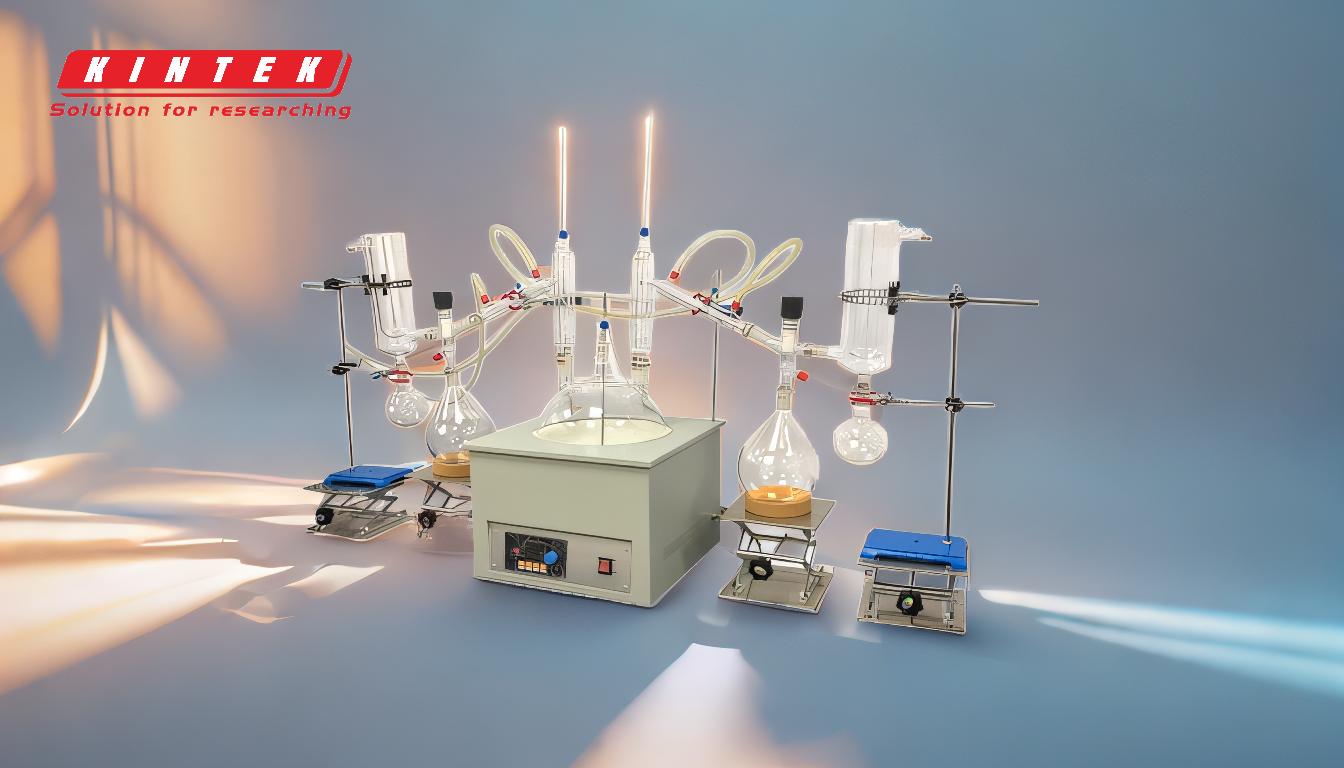Short-path distillation is a separation technique that operates under reduced pressure to lower the boiling points of substances, enabling the efficient separation of components based on their volatility. The process involves heating a liquid mixture in a flask, where the temperature is gradually increased to cause evaporation of specific components. A vacuum is applied to reduce atmospheric pressure, facilitating faster and more efficient distillation. The vapors travel a short distance to a condenser, where they are cooled and condensed back into liquid form. The condensed fractions are collected in separate flasks based on their weight, allowing for precise separation and refinement of the mixture.
Key Points Explained:

-
Reduced Pressure and Lower Boiling Points:
- Short-path distillation utilizes a vacuum to lower the atmospheric pressure within the distillation apparatus.
- Lower pressure reduces the boiling points of the components in the mixture, allowing for distillation at lower temperatures.
- This is particularly beneficial for heat-sensitive materials that may degrade at higher temperatures.
-
Heating and Evaporation:
- The liquid mixture is placed in a heated flask, often equipped with a magnetic stirrer to ensure uniform heating.
- The temperature is gradually increased to specific boiling points, causing the more volatile components to evaporate first.
- The heating process is carefully controlled to prevent overheating and degradation of sensitive materials.
-
Short Travel Distance:
- The vapors travel a short distance—typically just a few centimeters—from the heated flask to the condenser.
- This short travel distance minimizes the loss of distillate and reduces the risk of contamination, making the process more efficient and suitable for laboratory-scale applications.
-
Condensation and Collection:
- The vapors enter a condenser, where they are cooled and condensed back into liquid form.
- The condenser is often cooled by a recirculating chiller, ensuring efficient condensation of the vapors.
- The condensed liquid is collected in separate flasks based on the weight of each fraction, allowing for precise separation of components.
-
Fractionation and Refinement:
- The process can be repeated multiple times to achieve optimum separation and refinement of the mixture.
- Each fraction collected corresponds to a specific component of the mixture, based on its volatility and weight.
- This allows chemists to isolate and consolidate multiple desirable elements from a single sample.
-
Applications and Advantages:
- Short-path distillation is particularly useful for separating heat-sensitive compounds, high-boiling-point materials, and complex mixtures.
- The compact design of the apparatus makes it suitable for laboratory applications with minimal instrumentation footprint.
- The method is efficient, precise, and allows for the recovery of high-purity components.
-
Operational Parameters:
- The process operates under a pressure of less than 0.001mbar, ensuring minimal thermal stress on the materials being distilled.
- The temperature and pressure are carefully controlled to achieve the desired separation without causing degradation.
- The use of a multi-position receiver allows for the collection of multiple fractions in a single distillation run.
By understanding these key points, one can appreciate the efficiency and precision of short-path distillation, making it an invaluable technique in both laboratory and industrial settings for the separation and refinement of complex mixtures.
Summary Table:
| Key Aspect | Description |
|---|---|
| Reduced Pressure | Lowers boiling points, ideal for heat-sensitive materials. |
| Heating & Evaporation | Controlled heating ensures precise evaporation of volatile components. |
| Short Travel Distance | Minimizes distillate loss and contamination, enhancing efficiency. |
| Condensation & Collection | Vapors are cooled and collected in separate flasks for precise separation. |
| Applications | Separates heat-sensitive compounds, high-boiling-point materials, and mixtures. |
| Operational Parameters | Operates under <0.001mbar pressure for minimal thermal stress. |
Discover how short-path distillation can optimize your lab processes—contact us today for expert guidance!









